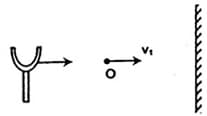Beats
Beats: Overview
This topic consists of various concepts like Resultant Beat Equation,Beats in Waves,, etc.
Important Questions on Beats
There is a source of sound (a tuning fork) moving towards a reflecting wall with a speed of . The velocity of the sound in air is and the frequency of the tuning fork is . The observer is between the source and the wall and is moving with some velocity towards the wall. The beat frequency heard by the observer is . If the tuning fork is waxed, the frequency beats heard by the observer becomes . If the new frequency of tuning fork is then is

A closed organ pipe and an open organ pipe of same length produce while vibrating in their fundamental modes. The length of the open organ pipe is halved and that of closed pipe is doubled. Then, the number of beats produced per second while vibrating in the fundamental mode is
Two whistles and have frequencies and respectively. An observer is standing in the middle of the line joining the two sources. Source and observer are moving towards the right with velocity and is standing to the left side. If the velocity of sound in air is . The number of beats per second listened by the observer are,
A closed organ pipe and an open organ pipe of same length produce while vibrating in their fundamental modes. The length of the open organ pipe is halved and that of closed pipe is doubled. Then, the number of beats produced per second while vibrating in the fundamental mode is
